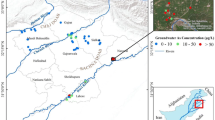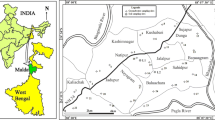Abstract
Natural contamination of groundwater with arsenic (As) occurs around the world but is most widespread in the river basin deltas of South and Southeast Asia. Shallow groundwater is extensively used in the Bengal basin for irrigation of rice in the dry winter season, leading to the possibility of As accumulation in soils, toxicity to rice and increased levels of As in rice grain and straw. The impact of As contaminated irrigation water on soil-As content and rice productivity was studied over two winter-season rice crops in the command area of a single tubewell in Faridpur district, Bangladesh. After 16–17 years of use of the tubewell, a spatially variable build up of As and other chemical constituents of the water (Fe, Mn and P) was observed over the command area, with soil-As levels ranging from about 10 to 70 mg kg−1. A simple mass balance calculation using the current water As level of 0.13 mg As L−1 suggested that 96% of the added arsenic was retained in the soil. When BRRI dhan 29 rice was grown in two successive years across this soil-As gradient, yield declined progressively from 7–9 to 2–3 t ha−1 with increasing soil-As concentration. The average yield loss over the 8 ha command area was estimated to be 16%. Rice-straw As content increased with increasing soil-As concentration; however, the toxicity of As to rice resulted in reduced grain-As concentrations in one of the 2 years. The likelihood of As-induced yield reductions and As accumulation in straw and grain has implications to agricultural sustainability, food quality and food security in As-affected regions throughout South and Southeast Asia.



Similar content being viewed by others
References
Abedin MJ, Cotter-Howells J, Meharg AA (2002) Arsenic uptake and accumulation in rice (Oryza sativa L.) irrigated with contaminated water. Plant Soil 240:311–319. doi:10.1023/A:1015792723288
Baffes J, Gautam M 1996 Is growth in Bangladesh’s rice production sustainable? Policy Research Working Paper #1666, World Bank, Washington DC, pp. 29
BBS (Bangladesh Bureau of Statistics) 2004 Statistical Yearbook of Bangladesh, pp.144 and 691
Bednar AJ, Garbarino JR, Ranville JF, Wildeman TR (2002) Preserving the distribution of inorganic arsenic species in groundwater and acid mine drainage samples. Environ Sci Technol 36:2213–2218. doi:10.1021/es0157651
BGS and DPHE. Kinniburgh DG and Smedley PL (Eds) 2001 Arsenic contamination of groundwater in Bangladesh. British Geological Survey Technical Report WC/00/19. British Geological Survey. Keyworth, UK
Cakmak I, Marschner H (1986) Mechanism of phosphorus-induced zinc deficiency in cotton. I. Zinc deficiency-enhanced uptake rate of phosphorus. Physiol Plant 68:483–490
Delowar HKM, Yoshida I, Harada M, Sarkar AA, Miah MNH, Razzaque AHM, Uddin MI, Adhana K, Perveen MF (2005) Growth and uptake of arsenic by rice irrigated with As-contaminated water. J Food Agric Environ 3:287–291
Dittmar J, Voegelin A, Roberts LC, Hug SJ, Saha GC, Ali MA, Badruzzaman BM, Kretzschmar R (2007) Spatial distribution and temporal variability of arsenic in irrigated rice fields in Bangladesh. 2. Paddy soil. Environ Sci Technol 41:5967–5972
Duxbury JM, Panaullah G (2007) Remediation of arsenic for agriculture sustainability, food security and health in Bangladesh. FAO Water working paper, FAO, Rome
Heikens A, Panaullah GM, Meharg AA (2007) Review of arsenic behaviour from groundwater and soil to crops and potential impacts on agriculture and food safety. Rev Environ Contam Toxicol 189:43–87
Huq SMI, Joardar JC, Parvin S, Correll R, Naidu R (2006) Arsenic contamination in food-chain: Transfer of arsenic into food materials through groundwater irrigation. J Health Pop Nutr 24:305–316
Ikehashi H, Ponnamperuma FN (1978) Varietal tolerance of rice in adverse soils. In Soils and Rice pp 801–825 Int. Rice Res. Instit. Los Banos
Islam MR, Islam S, Jahiruddin M, Islam MA (2004) Effects of irrigation water arsenic in the rice-rice cropping system. J Biol Sci 4:542–546
Juhasz AL, Smith E, Weber J, Rees M, Rofe A, Kuchel T, Sansom L, Naidu R (2006) In vivo assessment of arsenic bioavailability in rice and its significance for human health risk assessment. Environ Health Perspect 114:1826–1831
Lindsay WL, Norvell WA (1978) Development of a DTPA soil test for zinc, iron, manganese, and copper. Soil Sci Soc Am J 42:421–428
Loeppert RH, Inskeep WP (1996) Iron. In: Bigham JM (ed) Methods of soil analysis: chemical methods. Soil Science Society of America, Inc., Madison, pp 639–664
Loneragan JF, Grunes DL, Welch RM, Aduayi EA, Tengah A, Lazar VA, Cary EE (1982) Phosphorus accumulation and toxicity in leaves in relation to zinc supply. Soil Sci Soc Am J 46:345–352
Marin AR, Massecheleyn PH, Patrick WH Jr (1992) The influence of chemical form and concentration of arsenic on rice growth and tissue arsenic concentration. Plant Soil 139:175–183
Meharg AA, Hartley-Whitaker J (2002) Arsenic uptake and metabolism in arsenic resistant and nonresistant plant species. New Phytol 154:29–43
Meharg AA, Jardine L (2003) Arsenite transport into paddy rice (Oryza sativa) roots. New Phytol 157:39–44
Meharg AA, Rahman MM (2003) Arsenic contamination of Bangladesh paddy field soils: implications for rice contribution to arsenic consumption. Environ Sci Technol 37:229–234
Olsen SR, Sommers LE (1982) Phosphorus. In: Page AL et al. (eds) Methods of soil analysis: part 2. Chemical and microbiological properties. Agron. Mongr. 9. Amer. Soc. Agron. Madison, pp 403–430
Pal A, Nyack B, Das B, Hossain MA, Ahameda S, Chakraborti D (2007) Additional danger of arsenic exposure through inhalation from burning of cow dung cakes laced with arsenic as a fuel in arsenic affected villages in Ganga-Meghna-Brahmaputra plain. J Environ Monit 9:1067–1070
Roberts LC, Hug SJ, Dittmar J, Voegelin A, Saha GC, Ali AA, Borhan A, Badruzzaman M, Kretzschmar R (2007) Spatial distribution and temporal variability of arsenic in irrigated rice fields in Bangladesh. 1. Irrigation water. Environ Sci Technol 41:5960–5966
Saha GC, Ali MA (2007) Dynamics of arsenic in agricultural soils irrigated with arsenic contaminated groundwater in Bangladesh. Sci Total Environ 379:180–189
Samanta G, Chowdhury TR, Mandal BK, Biswas BK, Chowdhury UK, Basu GK, Chanda CR, Lodh D, Chakraborti D (1999) Flow injection hydride generation atomic absorption spectrometry for determination of arsenic in water and biological samples from arsenic affected districts of West Bengal, India and Bangladesh. Microchem J 62:174–191
Schoof RA, Yost LJ, Eickhoff J, Crecelius EA, Meacher DM, Menzel DB (1999) A Market basket survey of inorganic arsenic in food. Food Chem Toxicol 37:839–836
Smith AH, Lingas EO, Rahman M (2000) Contamination of drinking-water by arsenic in Bangladesh: a public health emergency. Bull WHO 78:1093–1103
Tang T, Miller DM (1991) Growth and tissue composition of rice grown in soil treated with inorganic copper, nickel, and arsenic. Comm Soil Sci Plant Anal 22:2037–2045
Van Breemen N, Moormann FR (1978) Iron-toxic soils. In Soils and Rice. Int. Rice Res. Instit. Los Banos, pp 781–800
Van Geen A, Zheng Y, Cheng Z, He Y, Dhar RK, Garnier JM, Rose J, Seddique A, Hoque MA, Ahmed KM (2006) Impact of irrigation rice paddies with groundwater containing arsenic in Bangladesh. Sci Total Environ 367:769–777
Watanabe FS, Olsen SR (1965) Test of an ascorbic acid method for determining phosphorus in water and NaHCO3 extracts from soils. Soil Sci Am Proc 29:677–678
Webb MJ, Loneragan JF (1988) Effect of zinc deficiency on growth, phosphorus concentration and phosphorus toxicity of wheat plants. Soil Sci Soc Am J 52:1676–1680
Williams PN, Price AH, Raab A, Hossain SA, Feldman J, Meharg AA (2005) Variation in arsenic speciation and concentration in paddy rice related to dietary exposure. Environ Sci Technol 39:5531–5540
Williams PN, Islam MR, Adomako EE, Raab A, Hossain SA, Zhu YG, Feldman J, Meharg AA (2006) Increase in rice grain arsenic for regions of Bangladesh irrigating paddies with elevated arsenic groundwater. Environ Sci Technol 40:4903–4908
Williams PN, Villada A, Deacon C, Raab A, Figuerola J, Green AJ, Feldman J, Meharg AA (2007) Greatly enhanced arsenic shoot assimilation in rice leads to elevated grain levels compared to wheat and barley. Environ Sci Technol 41:6854–6859
World Bank (2005) Arsenic contamination of groundwater in South and East Asian countries: Towards a more effective operational response. Report 31303 World Bank, Washington DC. pp 63
Yan WG, Dilday RH, Tai TH, Gibbons JW, McNew RW, Rutger JN (2005) Differential response of rice germplasm to straighthead induced by arsenic. Crop Sci 45:1223–1228
Zavala YJ, Duxbury JM (2008) Arsenic in rice: I. Estimating normal levels of arsenic in rice. Environ Sci Technol 42:3856–3860
Zavala YJ, Gerads R, Gurleyk H, Duxbury JM (2008) Arsenic in rice: II. Arsenic speciation in USA grain and implications for human health. Environ Sci Technol 42:3861–3866
Acknowledgement
The authors gratefully acknowledge the United States Agency for International Development Bangladesh Mission and the United Nations Food and Agriculture Organization for funding of this work.
Author information
Authors and Affiliations
Corresponding author
Additional information
Responsible Editor: Richard W. Bell.
Rights and permissions
About this article
Cite this article
Panaullah, G.M., Alam, T., Hossain, M.B. et al. Arsenic toxicity to rice (Oryza sativa L.) in Bangladesh. Plant Soil 317, 31–39 (2009). https://doi.org/10.1007/s11104-008-9786-y
Received:
Accepted:
Published:
Issue Date:
DOI: https://doi.org/10.1007/s11104-008-9786-y




